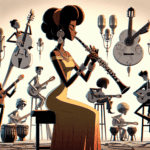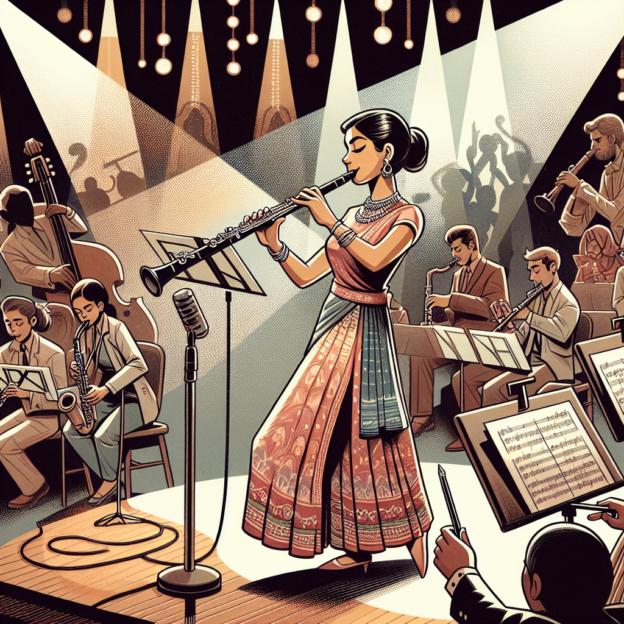The Clarinet's Jazz Journey in Theater
Jazz and theater have been dancing a delightful tango for decades, creating astonishing productions that captivate audiences, and right at the heart of this marvelous fusion is the clarinet. Yes, you heard that right! The clarinet, with its warm and expressive tone, has carved a niche for itself in jazz-influenced theater, showcasing its versatile nature and ability to convey emotions that words often cannot. Let's explore how this lovely instrument contributes to the captivating world of theatrical performances where rhythms and narratives blend.
Historical Roots and Modern Stage
The clarinet's rich historical roots can be traced back to the orchestras of Europe. Picture 18th-century musicians, skillfully weaving their melodies through concert halls! Today, it's not just about the concert stages. The clarinet finds itself amidst the colorful lights, dramatic stories, and stunning choreography of theater. Imagine the magic when a clarinetist's fingers flutter across the keys, breathing life into a song that propels a story forward.
Jazz-Infused Scores in Theater
Many theaters today rely on jazz-infused scores to enhance their narratives. This approach is particularly common in musicals, where the jazz genre's improvisational style allows performers to express their characters' emotions more deeply. Both new and experienced musicians often incorporate jazz techniques, learning to improvise solos that can leave an audience spellbound. Scenes involving romance, conflict, or joy come alive when the clarinet adds its flair.
| Emotion | Clarinet's Role |
|---|---|
| Romance | Soft, melodic phrases |
| Conflict | Sharp, staccato notes |
| Joy | Upbeat, lively melodies |
The Energy of Live Performance
The music is just the beginning! The physical act of performing—whether playing in the pit orchestra or during a live on-stage act—brings a certain energy that can't be replicated. Each note played by a talented clarinetist is filled with emotion, painting a picture alongside the actors' performances, pulling the audience deeper into the experience. Whether it's a vibrant, upbeat number or a somber ballad, the clarinet shines in particular arrangements, often taking center stage.
Clarinet in Jazz Ensembles
A standout feature is how the clarinet interacts with other instruments in jazz ensembles within theater. Each instrument tells its own story, but when the clarinet joins forces with brass and percussion, something truly magical happens. The blend of sounds creates a rich musical experience, allowing stories to be told without a single spoken word. Consider classic shows like “Porgy and Bess,” where the clarinet's sultry sound is unmatched, as it moves through joyful crescendos to sorrowful descents!
Mastering Improvisation
Practicing improvisation techniques is key for clarinetists aiming to contribute to jazz-influenced theater. It goes beyond playing notes on a page; it's about expressing oneself and taking the audience on a musical journey. Getting familiar with jazz standards, trying out different styles, and tapping into the spontaneity of the moment all play an important role. Jazz's freedom allows clarinetists to bring a personal touch to every performance, leaving a piece of themselves on that stage.
The Joy of Collaboration
Let's not forget the pure enjoyment of working with talented individuals from diverse backgrounds, which happens daily in theater settings. Musicians from various styles come together, enriching the performance as they blend different perspectives. Picture a rehearsal where the clarinetist teams up with a drummer and a vocalist, fusing various characters and energies into a beautifully chaotic arrangement that resonates through the audience!
Choosing the Right Instrument
For clarinetists stepping into the spotlight for jazz-influenced theater, having the right instrument is crucial. A quality clarinet that responds well to various styles is a must. Instruments like those made by Martin Freres are recognized for their ability to create dynamic timbres, allowing performers to easily engage in the musical conversation around them. A great instrument encourages a richer sound—allowing an artist's spirit to flow with the music. This depth of sound can create a more immersive experience for both the performer and the audience!
The Influence of Performance Space
The performance space itself shapes the clarinet's sound. Whether it's an intimate theater or a grand stage, the acoustics affect how the clarinet is heard. Theater musicians need to adapt, adjusting their playing style to suit the environment. For example, larger spaces might require stronger projection, while smaller, quieter settings allow for more subtle nuances to come through.
The Audience's Journey
As the audience experiences this wonderful blend of music and story, the clarinet's voice becomes a narrative of its own. Each performance is full of excitement, intrigue, and passion, designed to get shoes tapping and fingers snapping. And don't forget the goosebumps that come when a clarinet weaves its melodic spell, adding that special touch to a theatrical moment.
Embracing the Clarinet in Theater
Whether you're a clarinetist curious about stepping onto the theater stage or a theater fan eager to learn more about this mix of art forms, there's a whole world waiting for you to explore. It's exciting to see how the clarinet expresses joy, sorrow, and everything in between. Step into that theater, follow the clarinet's lead, and let the music sweep you off your feet!
In conclusion, the clarinet's role in jazz-influenced theater is irreplaceable. It's more than just an instrument. It's a bridge connecting narratives, feelings, and melodies, inviting audiences on a unique journey that enriches both performers and spectators alike. So, whether you're in the pit or on stage, remember that with the clarinet in hand, the possibilities are as endless as the stories we tell!
Table of Contents
- The Clarinet's Jazz Journey in Theater
- Historical Roots and Modern Stage
- Jazz-Infused Scores in Theater
- The Energy of Live Performance
- Clarinet in Jazz Ensembles
- Mastering Improvisation
- The Joy of Collaboration
- Choosing the Right Instrument
- The Influence of Performance Space
- The Audience's Journey
- Embracing the Clarinet in Theater







